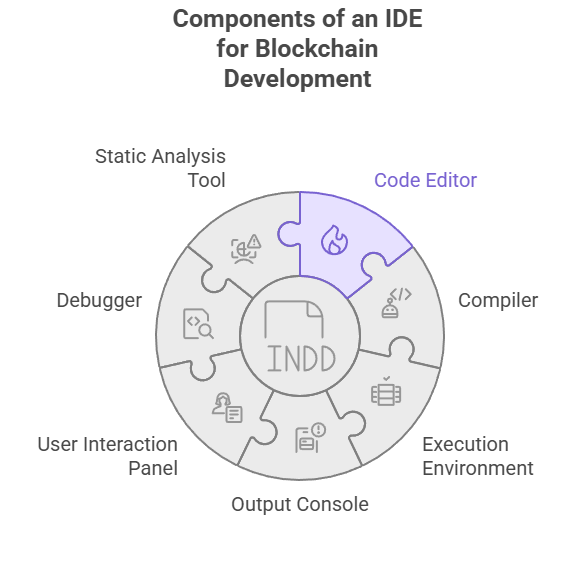Let us Discuss about Integrated Development Environment, Components Of An IDE, Benefits And Examples.
What is an Integrated Development Environment?
An Integrated Development Environment (IDE) is a piece of software that gives computer programmers all the tools they need to create software. Users may write, modify, compile, deploy, debug, and test code on this platform, which is basically a one-stop shop.
The primary purpose of an online platform such as Remix IDE is to create smart contracts on the Ethereum network. Without the requirement for installation, it provides a complete, one-stop web platform for developing blockchain-based applications. For illustrating the creation and implementation of DApps on Ethereum test chains, the Remix IDE is regarded as a necessary tool. Beginner Solidity programmers benefit from its fast development and testing environment. It provides mainnet and testnet environments for smart contract code creation, debugging, compiling, and deployment to Ethereum.
Components of an IDE for Blockchain Development

To expedite the development process, IDEs usually come with a number of integrated tools:
Code Editor: Developers enter their code and review files, including Solidity (.sol) files, in this central location. The editor in the Remix IDE has syntax highlighting and, if available, a just-in-time compiler that highlights errors and warnings while code is being produced.
Compiler: Compilers, such the Solidity compiler (solc), which translates high-level Solidity code into Ethereum Virtual Machine (EVM) bytecode for blockchain execution, are integrated into IDEs. The “Auto Compile” option in the Remix IDE is useful for instant error detection.
Execution Environment/Blockchain Simulator: For testing contracts without requiring a local blockchain setup, Remix IDE offers a JavaScript VM (Virtual Machine) that operates an isolated Ethereum node inside the browser. For testing purposes, pre-populated Ethereum accounts are included in this virtual environment.
Output Console: This console, which sits beneath the editor window, lets developers review transactions, verify that they were recorded, and see errors and debug information.
User Interaction Panel: By exposing public functionalities and data through buttons and text fields, this panel lets users interact with deployed smart contracts. Transaction hash, gas value, and execution cost are among the details that can be shown.
Debugger: The robust EVM debugger plugin in Remix IDE enables users to step through instructions and analyse memory, state, and stack data in order to conduct thorough tracing and analysis of EVM bytecode.
Static Analysis Tool: Solidity code can be examined by Remix IDE for flaws such as reentrancy issues.
Examples of Blockchain IDEs
Remix IDE: An IDE that is widely used in browsers for creating, testing, and implementing smart contracts, especially Solidity-written ones.
ChainIDE: An integrated development environment (IDE) that runs on the cloud and enables developers to collaborate with numerous blockchain systems.
SettleMint Code Studio: Built on top of Visual Studio Code, this IDE offers capabilities like the SettleMint SDK Command Line Interface (CLI) and Smart Contract Sets with pre-built templates.
Ganache: IDEs frequently employ a personal blockchain for Ethereum development to test smart contracts locally.
Benefits of IDE for Blockchain Development
Increased Productivity: The development process is streamlined and the time needed to create and implement smart contracts is decreased by IDEs, which combine several tools into a single interface.
Improved Code Quality: Code completion, syntax highlighting, and debugging improve code reliability, security, and efficiency.
Simplified Deployment: When deploying smart contracts to various blockchain networks, IDEs frequently include features to make the process easier.
Enhanced Collaboration: With the code sharing, review, and version control features of IDEs, developers may work together more easily.
Reduced Learning Curve: Developers can study and apply blockchain technology with IDEs’ user-friendly interfaces and vast toolboxes.
Network Connectivity and Integration with Other Tools
Remix IDE has the ability to connect to many Ethereum networks.
MetaMask: Through the “Injected Web3” environment, it easily connects with MetaMask. By linking Remix to MetaMask and the Ethereum network (such as the Ropsten or Goerli testnet), MetaMask can manage accounts and validate transactions. MetaMask injects a Web3 object into the browser, which Remix can access.
Ganache: The “Web3 Provider” environment allows Remix to be connected to the Ganache test chain for local development and testing. For DApp prototyping, Ganache is a personal blockchain client that offers ten accounts with 100 faux ether each.
Infura: To deploy DApps publicly, Remix can connect to Ethereum blockchain nodes on testnets (such as Ropsten) that are provided by Infura.
Development Workflow and Best Practices
Before switching to more structured tools like Truffle for production-level DApp development, developers frequently utilize the Remix IDE for the first development and testing of smart contracts. Remix enables syntax checks of data pieces before to the addition of functions, which aids in gradual development. Even while Remix stores files on its cloud server automatically, it’s a good idea to synchronize them to a local drive for backup purposes. While the Remix IDE’s design may evolve over time to improve user experience, its essential features never change.
